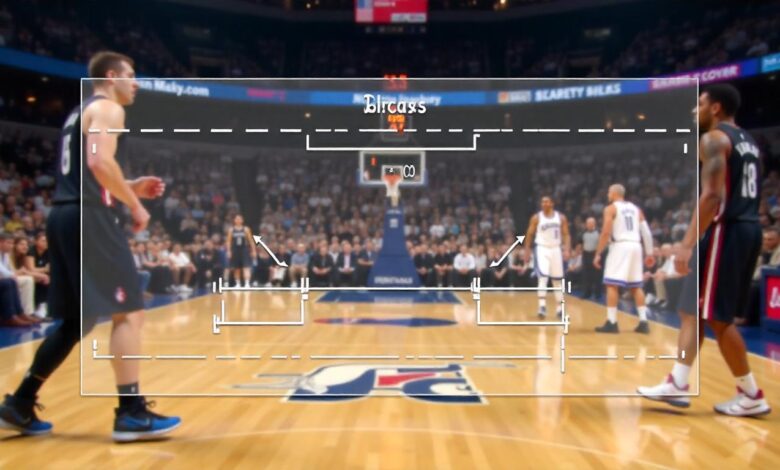Defensive Ballet: How Elite NBA Defenses Sculpt the Court

In the modern NBA, defense is no longer a rigid, reactionary wall—it is a finely choreographed ballet, where every player moves with purpose and precision, sculpting the court’s space like a master artist shaping clay. Elite defenses don’t simply respond; they anticipate, dictate, and influence the offensive flow. This article breaks down the core defensive schemes shaping today’s NBA, weaving in examples from a recent Boston Celtics vs Cleveland Cavaliers showdown to illustrate these concepts in action.
Contents
- 1 The Court as a Stage: Understanding Defensive Choreography
- 2 Switch-Heavy Schemes: Fluidity in Motion
- 3 Drop Coverage: The Anchor of Rim Protection
- 4 ICEing Ball Screens: Channeling Offensive Flow
- 5 Scram Switches: Emergency Defensive Adjustments
- 6 Weak-Side Zoning and Low-Man Rotations: Invisible Walls
- 7 Nail Help: The Last Line of Defense
- 8 Conclusion: The Art of Defensive Sculpting
The Court as a Stage: Understanding Defensive Choreography
Imagine the basketball court as a grand stage where defenders are dancers moving in synchrony. Each step, slide, and rotation is deliberate, designed to control the offensive players’ movement and cut off their options. The ultimate goal: force the offense into uncomfortable positions, provoke mistakes, and reclaim possession.
This defensive ballet relies heavily on communication, footwork, and spatial awareness, with each defender understanding not only their role but also how their movement impacts their teammates. Let’s dissect the key defensive schemes modern NBA teams employ to execute this sculpted defense.
Switch-Heavy Schemes: Fluidity in Motion
Switching on screens is one of the most visible and crucial elements of modern defense. Instead of fighting through every screen, defenders “swap” assignments like dancers exchanging partners mid-performance. This requires supreme awareness and trust.
Visual Metaphor:
Picture a group of ice skaters performing a complex routine, gliding seamlessly and exchanging positions without breaking rhythm. If one skater hesitates or loses balance, the entire sequence falters.
In the Celtics vs Cavaliers matchup, Jrue Holiday exemplified this defensive fluidity. Tasked with guarding multiple positions, Holiday’s ability to read the screen, call for the switch, and quickly adjust his stance was pivotal. His 2 steals and 1 block in the game weren’t just opportunistic plays—they were outcomes of his anticipation and sharp footwork during switches, allowing him to contest shots or intercept passing lanes.
Coaching Tip:
Train defenders to communicate loudly and early on screens. Develop drills where players practice switching under pressure, focusing on maintaining stance and positioning immediately after the switch to avoid mismatches.
Drop Coverage: The Anchor of Rim Protection
Drop coverage is a classic scheme that has evolved into a modern staple, especially against pick-and-roll offenses. The defender guarding the screener “drops” back toward the paint, forming a protective barrier—like a sculptor’s firm hand steadying the clay.
Visual Metaphor:
Envision a sculptor holding the base of a delicate statue, stabilizing it so the finer details above can be carved safely. Similarly, the drop defender anchors the paint, preventing easy drives and forcing opponents into tougher perimeter shots.
Al Horford’s role in the Celtics defense perfectly illustrates this principle. His ability to drop off the screen aggressively, contesting drives while remaining ready to rotate to shooters, was on full display. Horford’s 3 blocks and a defensive rating of 95 during the game underscore how drop coverage can anchor a team’s defense, limiting high-percentage shots near the rim.
Coaching Tip:
Emphasize timing and positioning in drop coverage drills. The drop defender must judge when to hedge on the ball-handler and when to retreat. Footwork here is key—shuffling laterally without overcommitting allows quick help or recovery rotations.
ICEing Ball Screens: Channeling Offensive Flow
ICE defense—also called “down” or “show” coverage—forces the ball-handler toward the sideline or baseline, effectively herding them into a predetermined trap.
Visual Metaphor:
Imagine herding sheep along a fence, guiding them into a pen with no chance of escape. ICE defense is the fence that contains the offense, limiting their options to a narrow corridor where help defenders await.
In the Boston Celtics vs Cleveland Cavaliers clash, Derrick White’s tenacious on-ball defense exemplified this concept. White’s ability to channel ball-handlers away from the middle, combined with quick hands and low, aggressive footwork, led to multiple forced turnovers and contested shots.
Coaching Tip:
Practice ICE principles in drills that simulate ball-screen scenarios with defenders positioning themselves to funnel the ball-handler to the sideline. Reinforce active hands and quick lateral slides, maintaining a low center of gravity to cut off driving lanes.
Scram Switches: Emergency Defensive Adjustments
No defensive system is perfect—sometimes screens catch defenders flat-footed or a mismatch occurs. The scram switch is a last-resort tactic where defenders immediately rotate and switch assignments mid-play to recover balance.
Visual Metaphor:
Think of a jazz band improvising during a sudden tempo change. Musicians shift roles fluidly, compensating for a missed cue to keep the melody intact.
During the game, Evan Mobley’s versatility stood out as he scrambled across the floor to cover mismatches, guard shooters, and provide help defense. His 4 steals and ability to contest shots on the weak side highlight how scram switches, executed with quick thinking and mobility, can disrupt the offense’s rhythm.
Coaching Tip:
Develop communication drills that include unexpected switches and rotations. Encourage defenders to anticipate scrambles and communicate clearly who is taking over which assignment.
Weak-Side Zoning and Low-Man Rotations: Invisible Walls
Although the NBA is predominantly man-to-man, weak-side zone principles often come into play, especially behind the ball. Defenders form an invisible, shifting wall, ready to “x-out” shooters and rotate down to help.
Visual Metaphor:
Imagine a sculptor shaping the clay not just where their hands touch but also subtly supporting from underneath—these weak-side defenders are the unseen force holding the shape together.
The Celtics’ defensive scheme uses this concept expertly, with players like Marcus Smart rotating from the weak side to contest shooters or help inside. This cohesion limits open looks and forces offenses to labor for every point.
Coaching Tip:
Drill rotations from weak-side defenders, focusing on quick, disciplined closeouts (“x-outs”) on shooters while maintaining help positioning inside. Footwork here must be explosive but controlled to avoid fouling or giving up space.
Nail Help: The Last Line of Defense
“Nail help” refers to the defender positioned at the nail—the free throw line area—ready to protect the paint and provide timely help or recovery.
Visual Metaphor:
Consider a lighthouse keeper watching the horizon, ready to warn ships of danger. The nail defender stands guard, scanning the court for threats and signaling teammates to adjust.
In the Celtics vs Cavaliers matchup, this role was crucial. When an offensive player beat their defender, the nail defender’s timely rotation prevented easy baskets. Horford and Mobley both embodied this role effectively, combining their rim protection with intelligent court vision.
Coaching Tip:
Encourage defenders playing nail help to keep a low stance, active hands, and eyes on both the ball and potential threats. They must be able to anticipate passes, read the offense, and rotate explosively without losing balance.
Conclusion: The Art of Defensive Sculpting
Modern NBA defense is a dance of anticipation, communication, and precision. Elite teams don’t just react; they shape the offensive flow by sculpting space, cutting off angles, and forcing opponents into predictable patterns. This defensive ballet requires every player to master footwork, timing, and teamwork.
The Boston Celtics vs Cleveland Cavaliers game offers a perfect microcosm of this philosophy, with players like Jrue Holiday, Al Horford, Derrick White, and Evan Mobley illustrating how technical prowess and situational awareness come together to form an unyielding defensive unit.
By training defenders to think like sculptors—carefully molding the court with every movement—and dancers—flowing fluidly in concert—coaches can build defenses that are as beautiful as they are effective.





